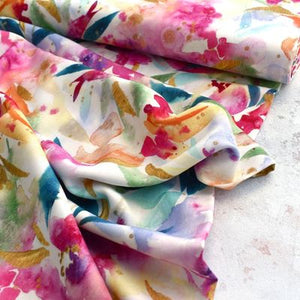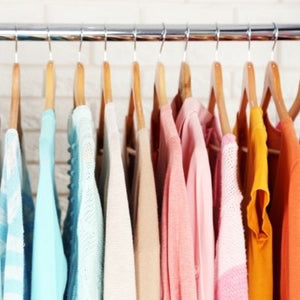It’s probably not surprising that the term “bottom weight” applies to fabrics particularly well-suited for the lower half of your body. Beyond that, it’s a pretty generic term that can apply to several fabric types. Confusing, right?! You may come across this term researching patterns or shopping for fabric, but what exactly is a bottom weight, and will you ruin your project if you use it -- gasp -- on TOP??
Let's take a look at what makes bottom weight fabrics unique and what garments they work well for. We'll also share a bit more about some of our favorite choices!

Need to Know
Bottom weight fabrics are medium to heavy weight and have a more durable construction. They are designed to hold up better to the activities and challenges of everyday life—walking, bending, sitting, squatting, etc. Think about this—would you make/wear a pair of fitted pants using a rayon challis or jersey knit? Probably not! It sounds more like a job for something like denim or corduroy, right? Not only does this added strength help the garments last longer, it can also provide better coverage, extra warmth, and even help protect the wearer.
As we mentioned, bottom weight fabrics are best suited for...bottoms! That means pants, shorts, skirts, overalls, jumpsuits, you get the idea. Their noted strength and durability also make them an excellent choice for blazers and other jackets, light weight coats, and even accessories (tote bags, aprons, etc). You may also find bottom weights useful for other garments, like certain styles of dresses or tops, where the extra thickness and structure may help you achieve the desired silhouette.

To help you further understand different types of bottom weight fabrics, let's take a look at some of the most popular, a few of their key facts, and their common uses. Find them broken down into categories from heaviest to lightest for easy comparison. Keep in mind that these are just general categories, and some fabrics (such as denim) may come in a wide variety of weights, textures, and contents.
The Heavy Hitters (10+ oz.)
- Cotton Twill
- Known for its twill weave, the signature diagonal pattern on the right side of the fabric, and high thread count, which further strengthens the fabric.
- Cotton twill is among the heaviest and most durable fabrics.
- May contain spandex for a bit of extra stretch and comfort!
- Available in a wide range of colors and prints.
- Typical Uses: Durable Pants and Jackets, Aprons, and Bags
- Similar Options: Sateen, Canvas, and Duck
- Denim
- Technically, a member of the twill family, denim is by far the most popular bottom weight, hence, why it deserves its own category!
- Available in a WIDE variety of weights, washes, and colors (although indigo is the classic favorite).
- May also contain spandex and polyester for added stretch and durability.
- Typical Uses: Durable Pants, Skirts, and Jackets
- Learn more about Denim HERE
- Corduroy
- Offers a similar weight and versatility to twill or denim but with a distinct corded pattern made up of channels in the fabric called “wales,”
- Typically found in the 10 oz range for bottom weights. It can also be found in lighter shirting weights best suited for button-ups and other tops or dresses.
- Found in a variety of fiber contents, although cotton is most common (with and without spandex).
- Typical Uses: Durable Pants, Skirts, and Jackets
- Similar Options: Velveteen
- Learn more about Corduroy HERE

Middle-of-the-Road (8-10 oz.)
- Suiting
- Smooth textiles known for their resistance to wrinkling and pilling, along with their drape and breathability.
- Available in a wide variety of weights and constructions—including twills, flannels, and gabardines.
- Previously reserved only for tailored suits, sewists now use suitings for any number of garments styles and silhouettes.
- While suitings are most commonly made from wool or other fibers blended with wool, modern textiles now recreate many of the same characteristics using blends of polyester, rayon, and other fibers.
- Typical Uses: Trousers, Skirts, Blazers and Other Jackets, and Dresses
- Ponte Knit
- Known for their unique combination of structure and moderate stretch, ponte knits are the best choice for more form-fitting garments.
- The double knit construction offers extra thickness and stability, along with more durability and strength when compared to other knits.
- Typical blends include rayon, polyester, nylon, and/or spandex.
- Available in a range of weights—look for the heavier/thicker options for pants and trousers.
- Typical Uses: Knit Pants and Leggings, Skirts, and Dresses
- Similar Options: Double Knit, Scuba Knit

Lighten Up! (8 oz. or less)
- Linen
- One of the oldest textiles in the world, linen continues to be known for its sustainability, versatility, and strength—it is a fabric made to last!
- Loved by sewists for its ease of sewing, breathability, and the unique aspect that garments continue to soften with each wash and wear!
- Often blended with cotton or rayon to achieve a desired texture or drape.
- Typical Uses: Looser Fitting Pants, Skirts, Blazers, and Other Jackets, Dresses, and Tops
- Learn more about Linen HERE
- Rayon Twill
- Unlike the structure of cotton twill, rayon twill is known for its softness and drape.
- Found in a wide variety of specific rayon fiber contents/brands—ex. Tencel, EcoVero, Lyocell
- Available in both bottom and shirting weights.
- Typical Uses: Looser Fitting Pants, Skirts, Drapey Jackets, and Button-Ups

Considering the constant workout given to these makes each time they are worn from knees to rear ends to hands-in-pockets, having a textile that can withstand everyday wear (and hopefully not tear!) is crucial. This is why durability is the most important factor in determining whether or not a particular fabric is appropriate for garments such as skirts and pants. That being said, many garments can be made from a variety of bottom weight fabrics to give them a different feel or to allow them to be worn in different climates. The same knee-length skirt pattern made in a rayon twill will have a very different look when constructed from a wool suiting or denim.
Sew Smart! A helpful hands-on way to get experience working with different fabrics is to sew the same pattern in a variety of textiles. Making a buttonhole, sewing a dart, or finishing a seam on the same pants pattern will be a completely different experience when done with cotton twill compared to linen.







Good article. I am going to send it on to others in my sewing group. Question (I think I know the answer) are all denims 10oz ?
Leave a comment